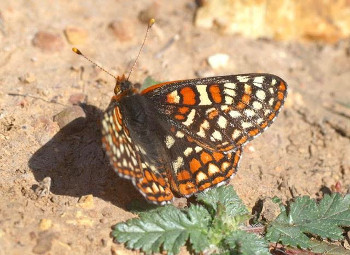Once one of California’s most common butterflies, populations have crashed even after its listing as an endangered species. The drought is no help.

The quino checkerspot, or QCB, has a complex life history that has been incompatible with the encroachment by development into its habitat. This butterfly is dependent upon particular host plants and survives in regional “metapopulations” wherein more stable core populations repopulate more fragile satellite populations that periodically disappear. If core populations are reduced or fragmented by development, resilience to environmental change is lost and the entire metapopulation may go extinct, even if what superficially appears to be good habitat remains. Orange County’s populations have all gone this route. Indeed, a scientific study has shown consistent disappearance of QCB within a kilometer of development. And while caterpillars may rest, or “diapause,” for years in times of drought, the current prolonged drought could nevertheless stress populations to the breaking point.
Currently, butterflies only survive in relic populations in Riverside and San Diego Counties, and northern Baja California. The remaining populations are divided between coastal and montane groups. The Western Riverside County Multiple Species Conservation Plan conserved coastal habitat in the Murrieta Hogbacks, but butterflies have not been found there in recent years, coincident with encroachment by development. The metapopulation structure has probably been fatally compromised.
A new problem area for the QCB is the Otay Lakes area in the South County near Chula Vista, where development is planned. This location is “ground zero” for the butterfly in coastal San Diego, with one smaller population to the south on Otay Mountain. EHL is concerned that the phenomenon of population extinction might well repeat itself. Even though this development was anticipated by the San Diego Multiple Species Conservation Program (MSCP) – actually “grandfathered” into the plan as project approval antedated the MSCP’s scientific process – the QCB is not a species covered by the MSCP. So, the listing mandates a fresh look, albeit with the goal of changing the plan only to the extent necessary.
EHL submitted expert comment letters on the draft Environmental Impact Report issued by the County of San Diego for development north of Otay Lake. We believe that QCB conservation is best addressed collaboratively and comprehensively on a regional scale, and have urged the County to restart its “Quino Amendment” to the MSCP. In this forum, landowners and other parties can work together using the best science, and as necessary, fashion creative solutions to save vital core populations.


